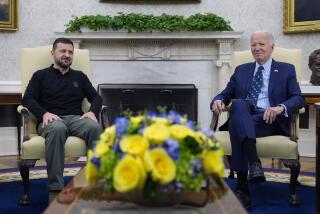U.S. begins using Predator drones in Libya
- Share via
Reporting from Washington — President Obama has approved the use of armed Predator drone aircraft to launch airstrikes against ground targets in Libya, the latest sign of mounting concern in Washington that the NATO-led air campaign has failed to stop Moammar Kadafi’s forces from shelling the besieged city of Misurata and other populated areas.
Defense Secretary Robert M. Gates, who announced the decision at a Pentagon news conference, said Predators armed with Hellfire missiles would be used to augment airstrikes by warplanes from other North Atlantic Treaty Organization nations against the intensifying attacks by forces loyal to Kadafi.
The decision marks a resumption of a direct combat role for U.S. aircraft in Libya and represents a shift for the White House. It follows decisions by France, Italy and Britain this week to send military advisors to assist the poorly armed, inexperienced and disorganized rebel force based in eastern Libya.
The first Predator mission was launched Thursday, but the pilotless plane was forced to turn back because of poor weather conditions, said Marine Gen. James Cartwright, vice chairman of the Joint Chiefs of Staff.
He said two drones would fly 24 hours a day and focus initially on targets around Misurata, Libya’s third-largest city and the focal point of resistance in western Libya, where the outgunned and outnumbered opposition forces have held out against relentless attacks by Kadafi’s forces.
“What they will bring that is unique to the conflict is their ability to get down lower, therefore to be able to get better visibility on targets,” Cartwright said. “They are uniquely suited for urban areas.”
As the siege has deepened, high-flying NATO fighter planes have struggled to find and attack the military squads that have fired mortars and other weapons into Misurata, killing dozens of people. Mortars are small, portable weapons that can be easily hidden and quickly moved after being fired.
U.S. Army units are equipped with radar that tracks the trajectory of incoming mortar shells and allows U.S. forces to swiftly return fire. But NATO has no troops or radar units on the ground in Libya. The Predators could help fill the gap, however.
Gates denied that the decision to deploy the Predators indicated that U.S. forces were being drawn deeper into a conflict that increasingly appears to be a military stalemate, in effect cutting Libya in two.
“I don’t think that any of us see this as mission creep,” Gates said. He called the Predators a “modest contribution” to the NATO-led effort.
The Obama administration will give the rebels $25 million in vehicles and other supplies from excess military stocks, but it has ruled out sending weapons and other forms of lethal aid for now. Administration officials remain concerned about giving weapons to such a disorganized group about which little is known.
The Pentagon initially led the international air campaign to protect civilians from Kadafi’s army, but after NATO was given command two weeks ago, Obama said the U.S. military role would be limited to providing surveillance, refueling and other noncombat support operations.
That strategy left NATO without low-flying U.S. aircraft capable of carrying out precision strikes in urban areas — a mission that the Predators, armed with the missiles and live-video surveillance cameras, are designed to do.
The aircraft have their limits, however. Predators are notoriously poor at flying in bad weather and carry only two missiles, giving them relatively limited combat capabilities.
If the armed drones fail to slow Kadafi’s attacks, especially in Misurata, the administration could face more pressure to send A-10s and AC-130s, manned planes specifically designed for low-level attack. The Pentagon has said such planes are on standby in case they are needed by NATO.
Gates defended the results of the air operation so far, saying the NATO-led effort had prevented Kadafi’s forces from taking the rebel stronghold of Benghazi and from carrying out a massacre of civilians, as the Obama administration had feared.
The war in Afghanistan has left the U.S. military the “most stretched” compared with other NATO nations, Gates said. He added that the administration had agreed to participate in the Libyan operation with the clear understanding that it would play primarily a support role to the Europeans, who have a far more direct interest in Libya’s stability than the U.S., he said.
He warned against expecting quick results. “I think there’s an understanding that the real work will have to be done by the Libyans themselves,” he said. “We can provide them some air cover,” but driving Kadafi from power is “likely to take a while.”
The Libyan rebels said Thursday that they had taken control of a post on the border with Tunisia, forcing government soldiers to flee over the frontier and possibly opening a new channel for opposition forces in Kadafi’s bastion in western Libya, the Associated Press reported.
The reported capture of the border crossing came after three days of intense fighting outside the desert town of Nalut, about 140 miles southwest of the capital, Tripoli, said rebel leader Shaban abu Sitta.
More to Read
Sign up for Essential California
The most important California stories and recommendations in your inbox every morning.
You may occasionally receive promotional content from the Los Angeles Times.











